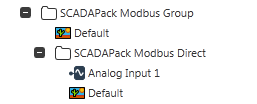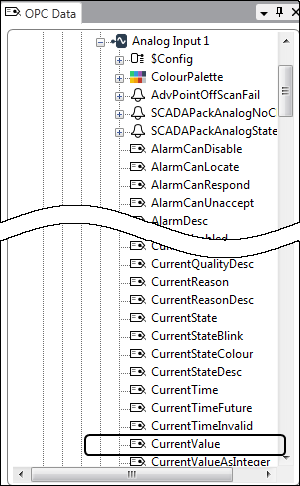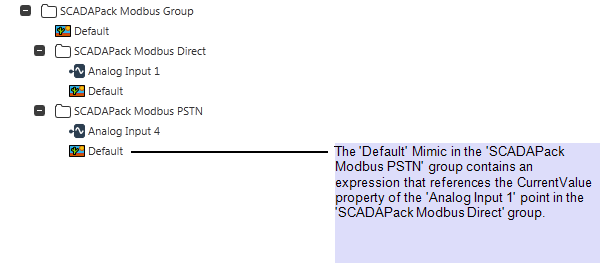NOTE: Tags do not apply to Template expressions, instead you use Template Parameters.
You can use an OPC tag to reference the properties of a database item. An OPC tag has the following syntax:
"<Item>"
"<Item>.<Property>"
"<Item>.<Database Aggregate>"
"<Item>.<Database Aggregate>.<Property>"
Where:
<Item>is the location of the database item. The location can be relative or absolute (see Relative and Absolute References).If the item is in a different database, the syntax requires a prefix of:
<System>:
Where
<System>is the name of the database that contains the item.<Property>is the name of the property tag that you want to reference<Database Aggregate>is the name of the database aggregate that has the required property. Database Aggregates are extensions to a table in the database and they have their own name, table, properties and methods. For more information, see Aggregates in the ClearSCADA Guide to the Database.
For example, "MK:NERegion.Level.CurrentValue" is a reference to the CurrentValue property of the Level database item that is stored in the NERegion group in the MK database.
If you omit the <property> in the tag, the tag will use the default property for the defined database item or aggregate. The default property for an item or aggregate varies according to the type of item or aggregate, for example, the default property for a point is CurrentValue.
Example 1-Absolute reference to a default property:
The following example uses an absolute reference to the default property of a point named 'Analog Input 1':
"SCADAPack Modbus Group.SCADAPack Modbus Direct.Analog Input 1"
This assumes that the 'Analog Input 1' point is in the 'SCADAPack Modbus Direct' group which is in the 'SCADAPack Modbus Group' group.

Example 2-Absolute reference to a specific property:
This example uses an absolute reference to the same 'Analog Input 1' point that was used in Example 1, except this time the expression defines a specific property of the point:
"SCADAPack Modbus Group.SCADAPack Modbus Direct.Analog Input 1.CurrentValue"
The specified property is CurrentValue.

Example 3-Absolute reference to the default property of a database aggregate:
This example uses an absolute reference to the same 'Analog Input 1' point that was used in Examples 1 and 2, except this time the expression references the default property of the point's 'Historic' database aggregate:
"SCADAPack Modbus Group.SCADAPack Modbus Direct.Analog Input 1.Historic"
Example 4 - Absolute reference to a specific property of a database aggregate:
This example uses an absolute reference to the same 'Analog Input 1' point that was used in Examples 1, 2, and 3 except this time the expression references the a specific property of the point's 'Historic' database aggregate:
"SCADAPack Modbus Group.SCADAPack Modbus Direct.Analog Input 1.Historic.PrevLogValue"
The specified property is PrevLogValue.
Example 5 - Relative reference to a specific property:
This example uses a relative reference to the CurrentValue property of the same 'Analog Input 1' point that was used in Examples 1-4 inclusive. We assume that the item for which the expression is being created is stored in the 'SCADAPack Modbus Group' group.
".SCADAPack Modbus Direct.Analog Input 1.CurrentValue"

The dot at the start of the reference indicates that to get to the point that has the tag, ClearSCADA has to go up one level in the hierarchy from the item that contains the expression (1 dot is equal to going up 1 level in the hierarchy).
Example 6 - Relative reference to a different level in the database tree-structure:
This example uses a relative reference to the CurrentValue property of the same 'Analog Input 1' point that was used in Examples 1-5 inclusive. This time, we assume that the 'SCADAPack Modbus Group' group contains a group named 'SCADAPack Modbus Direct' and another Group named 'SCADAPack Modbus PSTN'. The item that contains the expression is stored in the 'SCADAPack Modbus PSTN' group and it references the 'Analog Input 1' point that is in the 'SCADAPack Modbus Direct' Group.
"..SCADAPack Modbus Direct.Analog Input 1.CurrentValue"

The dots at the start of the reference indicate the number of levels in the hierarchy between the item that contains the expression and the point that has the tag. So, the dots represent the 'SCADAPack Modbus Group' group and the 'SCADAPack Modbus Direct' group.
Example 7 - Reference to an item in another database:
This example uses a reference to the CurrentState property of a point named 'Point 1'. The 'Point 1' point is stored in a group named 'SCADAPack Modbus Group' that is in another database. The other database (system) is named 'MK'.
"MK:SCADAPack Modbus Group.Point 1.CurrentState"